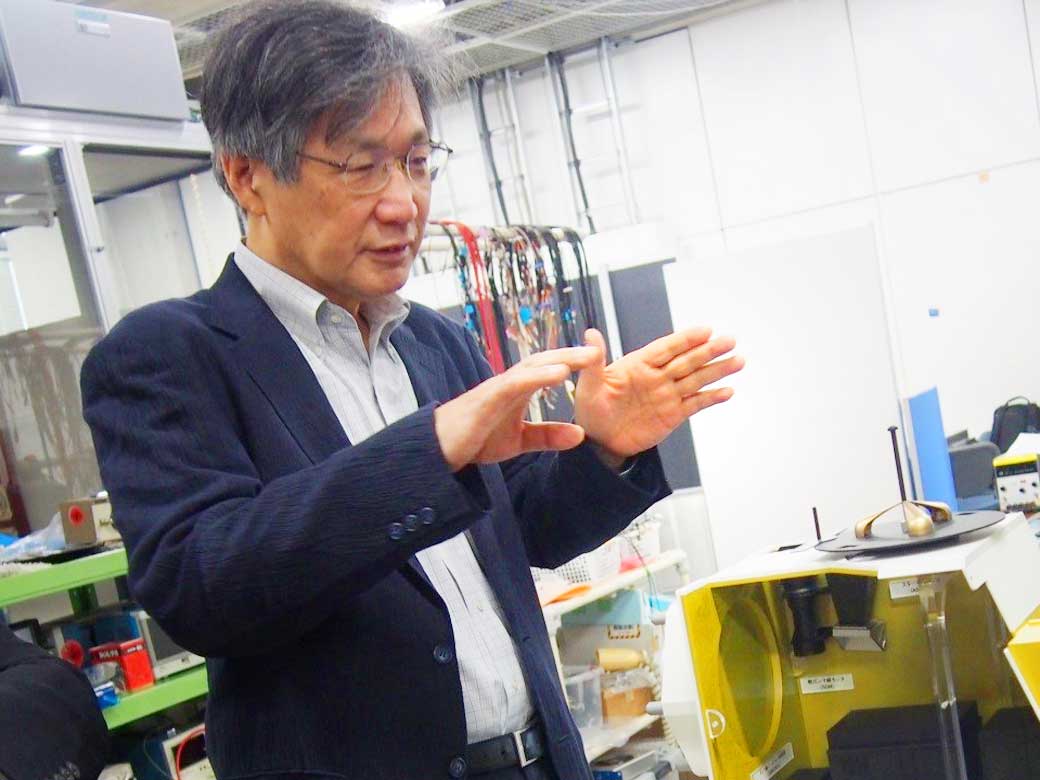Waseda Frontline Research Vol. 5, Part 1 – A new challenge to solve the mysteries of the universe
Fri, Oct 23, 2015-
Tags
Physicist and cosmic rays specialist Professor Shoji Torii
Waseda Research Institute for Science and Engineering
Director of WASEDA Institute for Space Science Observation System
Representative of CALET Project
Seeking out the true nature of cosmic rays
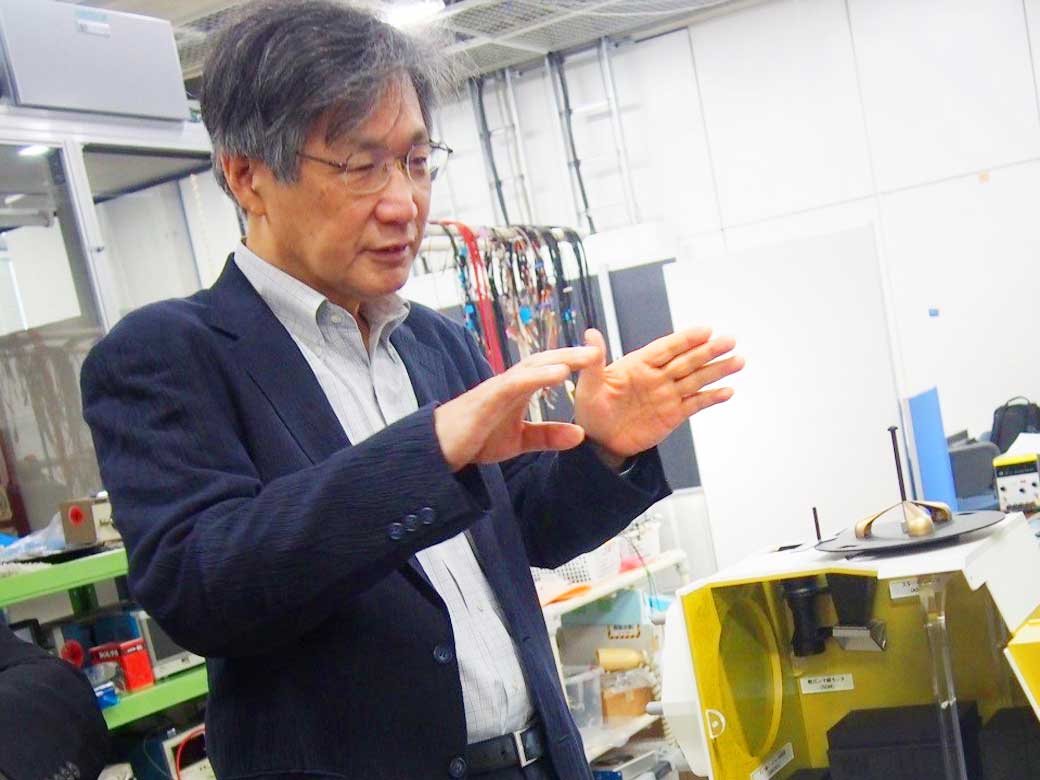
In August 2015, the Tanegashima Space Center launched the H-II Transfer Vehicle Kounotori 5. Kounotori is a spacecraft constructed to deliver necessary commodities such as water, food, and clothing as well as various devices and equipment to astronauts on the International Space Station (ISS). One of these devices is an experimental unit that is garnering worldwide attention. It is called the “CALorimetric Electron Telescope (CALET).” As CALET has launched into space and will soon begin conducting experiments, we took this opportunity to speak with Professor Shoji Torii from Waseda’s Research Institute for Science and Engineering to shed light on the CALET and its great potential.
(Interview Date: September 10, 2015)
Launch successful! Now beginning preparations for space observation!
Hello. I’m Shoji Torii from Waseda University. I am the representative of the CALorimetric Electron Telescope (CALET) project, which was launched into space some days ago.
The Kounotori spacecraft that houses CALET was launched into space on the night of August 19. Around three weeks have passed since then. I went to the site to see the launch but did not expect it to be so magnificent. The site suddenly lit up when the engine ignited that night and I was thrilled to see the rocket take flight.
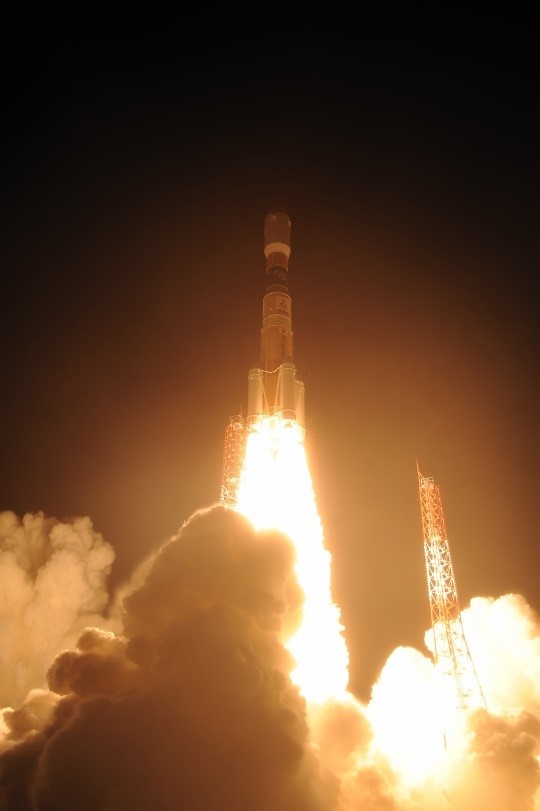
Launching of Kounotori 5/H-IIB Rocket 5 (Source: (C) Japan Aerospace Exploration Agency (JAXA))
However, it was too early to say the launch was successful simply because the rocket had lifted off safely. After the launch, the auxiliary booster rockets attached to both sides of the rocket detached, followed by the first and second stages of the main rocket. Kounotori was released after the cover (referred to as the “fairing”) separated. After about two days following the launch, the Kounotori approached the ISS where it was captured by a robot arm for docking. Now that the Kounotori has docked, we can now say the launch was successful.
After the Kounotori docked according to schedule, CALET was taken out of the spacecraft and installed on Port No. 9 of the extravehicular experimental platform of the Japanese Experiment Module Kibo. The installation was successfully completed on August 24, five days after the initial launch.
At this time, we are now running checks to make sure all equipment is operating normally. This inspection is referred to as “check-out” and is performed from the ground by remote control. At present, there are no major problems and everything is running smoothly. The astronaut Kimiya Yui is now staying on the ISS to perform necessary operations only possible in space. I was incredibly happy when I saw a picture of him beside a window with CALET on the other side.
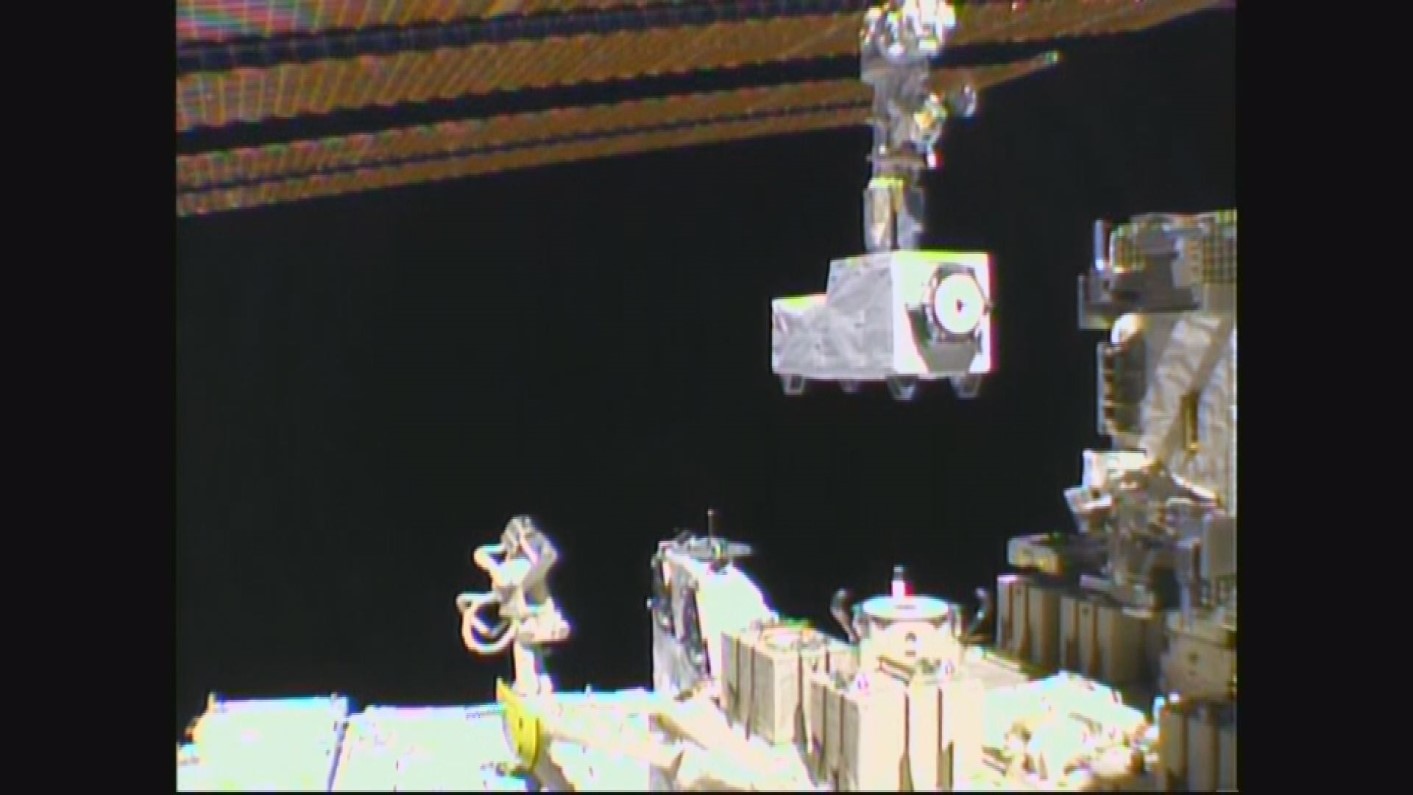
Documenting the relocation process from the exposed palette of the CALorimetric Electron Telescope (CALET) to the extravehicular experimental platform (Source: (C) Japan Aerospace Exploration Agency (JAXA))
* CALET is in the right of the center.
Understand cosmic rays, understand the universe
I would like to start by explaining cosmic rays so that you can understand what CALET is. Cosmic rays have consistently been a cutting-edge topic in physics ever since their discovery around 100 years ago. Studies of cosmic rays have led to important findings such as the discovery of positron and meson.
However, we still do not know the basic characteristics of cosmic rays such as where they are generated, how they accelerate, or their highest energy.
Cosmic space seems to be empty, but there are an immense number of particles traveling around. These are protons and electrons, which are smaller than atoms. Although they are very small, there is an immense number of them traveling around in space. If, for example, you were to spread out your hand in cosmic space, it would be struck by over 100 particles per second. These particles are called cosmic rays.
Cosmic rays are emitted by things like the sun and the Milky Way Galaxy (which is home to Earth). High-energy cosmic rays in particular come all the way from outside our solar system. However, it is not fully understood where they come from and why they have such high energy. This is one of the unsolved mysteries of the universe. CALET is a device designed to observe these high-energy cosmic rays. Revealing the true nature of high-energy cosmic rays will yield valuable clues to understanding their origin and their propagation method as well as the origins of the universe.
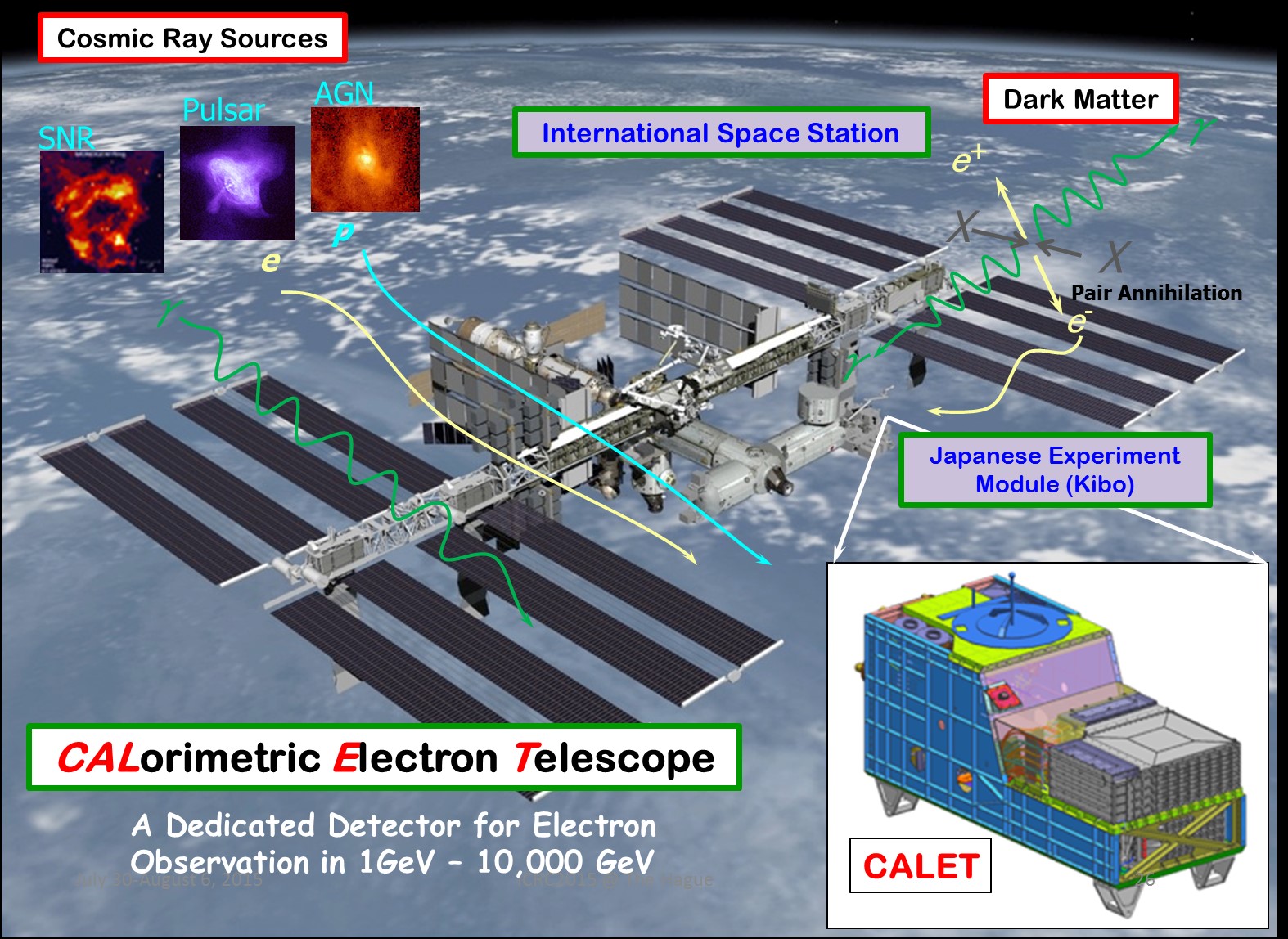
CALET-CALorimetric Electron Telescope (Source: CALET website http://calet.jp/)
We have been observing cosmic rays since the 1990s, when a balloon observer was launched to perform observation in the atmosphere at an altitude of about 35 km. However, no matter how high their altitude in the atmosphere, cosmic rays from outside of inner space are subject to the influence of air. For this reason, large equipment cannot be used. Knowing there is no way to conduct more precise and larger-scale observation of cosmic rays other than performing observations in cosmic space, we spent around ten years developing CALET.
CALET is Japan’s first full-scale piece of equipment for observing cosmic rays in cosmic space. There are only two or three teams in the world observing electrons, one of the most important cosmic rays. CALET is capable of performing observation in the high-energy range, which has proved difficult for equipment from other countries. Researchers around the world are looking forward to CALET’s discoveries.
We will hear more about the CALorimetric Electron Telescope (CALET) in part two of this three-part series.
Profile
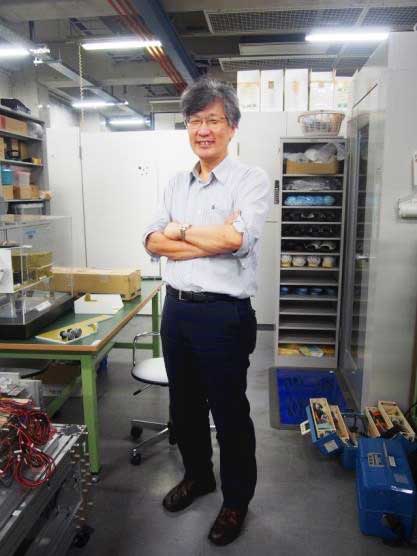
Professor Shoji Torii graduated from Kyoto University’s Faculty of Science in 1972. He completed the doctoral program at Kyoto University’s Graduate School of Science without a degree in 1997 and obtained a Doctorate of Science at Kyoto University in 1978. Torii became an incentive researcher at the Japan Society for the Promotion of Science (Institute for Cosmic Ray Research, the University of Tokyo) in 1977, a researcher at Tokyo University’s Institute for Cosmic Ray Research in 1979, and a research associate at Utah State University’s Faculty of Physics. Torii became an assistant, instructor, Associate Professor and Professor at Kanagawa University’s Faculty of Engineering in 1983. He became a Professor of Waseda University’s School of Science and Engineering in 2004. He currently serves as Professor at the Waseda Research Institute for Science and Engineering, Director of WASEDA Institute for Space Science Observation System, and representative of the CALET project. He is an expert on the physics of cosmic rays and was Commissioner of the Japan Physical Society (61st and 62nd periods).
Website/Video Site
Torii Laboratory, Waseda University Research Institute for Science and Engineering
CALET – CALorimetric Electron Telescope website
Video of CALET upon space station Kibo
Recent News
Japanese space research and development on International Space Station
Recent Research
- Observing Cosmic Rays in Space(The Centenary of the Discovery of Cosmic Rays)
- “Calet Mission for Exploring the High Energy Universie” – IEEJ Transactions on Fundamentals and Materials Vol.132 pp.603-608. (2012)
- An Excess of Cosmic Ray Positrons and Electrons May Confirm Dark Matter?
- For more, please refer to the following link: http://www.crlab.wise.sci.waseda.ac.jp/


